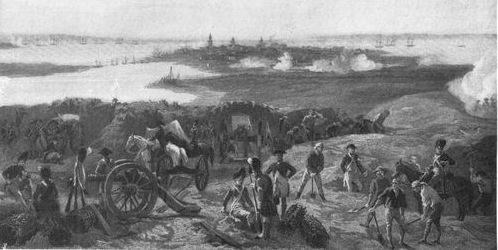 |
Patriot Resource Index
 American Revolution Index
American Revolution Index
 Surveys and Lists
Surveys and Lists
Military Campaigns
-:Saratoga Campaign
-:Southern Campaign:
Part I
Part II
Timeline
Department Cmdrs
-:West Florida Campaign
-:Yorktown Campaign
Reference Lists
Surveys By Year
 American Revolution Index
American Revolution Index
 Battles
Battles
 Documents
Documents
 Events
Events
 Landmarks & Places
Landmarks & Places
 People: The Patriots
People: The Patriots
 People: Continental Army
People: Continental Army
 People: British Army
People: British Army
 Timelines
Timelines
 Books
Books
 Multimedia
Multimedia
 Links & Other Resources
Links & Other Resources
Search the Site
Site Map
Contact Us
PatriotResource.com:
Main Index
Film Index
Film: Gladiator
Film: National Treasure
Film: The Patriot
Film: Tombstone
Films: General
Films: Fantasy
Films: SciFi
History: 1775-1781
History: September 11th
Lord of the Rings
NORAM Road Trips
OtherWorld: Index
TV Series: Index
TV: Battlestar Galactica
TV: Caprica
TV: Deadliest Catch
TV: Lost
TV Series: Action
TV Series: Animated
TV: BBC Presentations
TV Series: Comedy
TV Series: Drama
TV: Fantasy/SciFi
TV Series: Western
TV Series: Reviews
Military Campaigns
-:Saratoga Campaign
-:Southern Campaign:
Part I
Part II
Timeline
Department Cmdrs
-:West Florida Campaign
-:Yorktown Campaign
Reference Lists
Surveys By Year
Site Map
Contact Us
Main Index
Film Index
Film: Gladiator
Film: National Treasure
Film: The Patriot
Film: Tombstone
Films: General
Films: Fantasy
Films: SciFi
History: 1775-1781
History: September 11th
Lord of the Rings
NORAM Road Trips
OtherWorld: Index
TV Series: Index
TV: Battlestar Galactica
TV: Caprica
TV: Deadliest Catch
TV: Lost
TV Series: Action
TV Series: Animated
TV: BBC Presentations
TV Series: Comedy
TV Series: Drama
TV: Fantasy/SciFi
TV Series: Western
TV Series: Reviews

The result of Major Patrick Ferguson's tactics was that on October 7, 1780, several bands of Overmountain Men and militia defeated Ferguson's Tory force at the Battle of King's Mountain, South Carolina. This loss forced General Cornwallis to retreat back to Winnsboro, South Carolina. It also demoralized the Tories. They did little to support the British efforts in the South from this time on.
On October 5, 1780, Congress had given General George Washington full authorization to choose the Southern Department Commander on October 5th. Washington had recommended Maj. General Nathanael Greene for the post back in May as Maj. General Benjamin Lincoln's replacement following the surrender of Charleston, South Carolina. However, Congress had overruled Washington's selection and Gates had been selected at the time. Washington received Congress' resolution on October 13th and again chose Greene for the post on the very next day on October 14th. On October 22nd, Greene accepted his orders from Washington and set out from camp with his designated second-in-command, Baron von Steuben. They travelled to Philadelphia and presented Washington's letters to Continental Congress. On October 31, 1780, both appointments were approved by Congress.
On December 2, 1780, Greene officially took command of a bedraggled Southern Continental army from Maj. General Horatio Gates in Charlotte, North Carolina. He was joined by Brig. General Daniel Morgan, who had recently put aside personal issues to return to field. General Greene found the army, underequipped, demoralized and lacking discipline. To buy time to rebuild and outfit his army, he split it, giving command of the smaller, more mobile portion to Morgan. Morgan left Charlotte on December 21, 1780. General Cornwallis recognized the strategy and sent Lt. Colonel Banastre Tarleton after Morgan to either destroy his force or drive Morgan back to him.
After nearly a month of maneuvering, General Morgan stood and fought Lt. Colonel Tarleton at the Battle of Cowpens, South Carolina on January 17, 1781. With the help of Andrew Pickens, Morgan used British expectations of militia cowardice from the Battle of Camden and Tarleton's tendancies of aggressive charges to draw him in and double-flank his force. The loss was Britain's largest in the way of captured men and lost munitions. The Race to the Dan River followed as Lt. General Charles Cornwallis pursued General Greene north across South and North Carolina. Cornwallis was again thwarted even after burning his baggage train to hasten his march, because Greene had boats ready to carry his army across the swollen Dan River. During the retreat, General Morgan had to retire to his home in Virginia, when painful sciatia made it impossible for him to ride a horse.
General Cornwallis retreated back south to rebuild his supplies, made winter camp at Hillsborough, North Carolina and awaited Greene's return. General Greene finally crossed the Dan back into North Carolina on March 1, 1781. After two weeks of manuevering, Greene met General Cornwallis at the Battle of Guilford Courthouse, North Carolina on March 15, 1781. Cornwallis held the field, but he had sustained heavier casualties than Greene and was unable to pursue Greene. Cornwallis now changed his strategy. He had been unable to tame the militia bands led by Andrew Pickens, Francis Marion and Thomas Sumter, so he decided to abandon the Carolinas and move north into Virginia, since it was the middle of the colonies. His new strategy hinged on he and Lt. General Henry Clinton trapping General Washington in the middle colonies.
After receiving orders from General Clinton, General Cornwallis established a fort at Yorktown, Virginia. Then in September of 1781, the French navy finally arrived and after twice skirmishing with the British navy, occupied Chesapeake Bay, which allowed General Washington to besiege Cornwallis, starting the Battle of Yorktown, Virginia on October 9, 1781. On October 17, 1781, General Cornwallis surrendered, but claiming illness, sent his second-in-command, Brig. General Charles O'Hara to the official ceremony. O'Hara attempted to surrender to the French, but was directed to General Washington, who then directed him to his second-in-command, Maj. General Benjamin Lincoln. This ended the last major engagement of the Revolutionary War.
Available at Amazon.com:

The Road to
Guilford Courthouse
by John Buchanan
